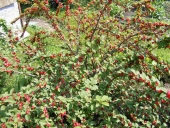
 2
2




 4
4





Striving to grow things as naturally, simply, and cheaply as possible! 
My YouTube channel
 3
3




 3
3




Iterations are fine, we don't have to be perfect
My 2nd Location:Florida HardinessZone:10 AHS:10 GDD:8500 Rainfall:2in/mth winter, 8in/mth summer, Soil:Sand pH8 Flat
 3
3




Sometimes the answer is nothing

 4
4




 1
1




Sue Rine wrote:My main experience with fruit trees from seed has been with peaches. They pretty reliably fruit in their 3rd year. I've also planted quite a few dozen chestnuts over several years. So far just one has fruited/nutted and it did it 18mths from planting the seed! I have some plum and apricot seedlings that are 2-3 years old but none have fruited yet.
The peaches have been smaller than the parent fruit but they're good flavour and freestone so easy to use for bottling/canning.
$10.00 is a donation. $1,000 is an investment, $1,000,000 is a purchase.
 3
3








Robert Baerg wrote:I have grown lots of stone fruit trees (plums, chums, bush cherries, peaches and apricots) from seed and they typically will start blooming in the 3rd year. Apples on the other hand are slower. The only one that has bloomed before 5 years is the Siberian crabapple.
$10.00 is a donation. $1,000 is an investment, $1,000,000 is a purchase.
 8
8








Robert Baerg wrote:Genetics are an amazing thing. I took 6 seeds from a yellow Russian plum and germinated them. After 3 years one of trees started producing dark red plums. upon closer observation of all 6 of the trees it was quite clear that all of them had unique feature: tree form, branching structure, leaf size and shape, blooming time, flower structure (single vs clusters on a bud). Upon returning to the mother tree location I observed that there were several sandcherry bushes within pollination range of the yellow plum. So it now appears that I have 6 different varieties of CHUM (cherry/plum cross). All of them have reached blooming stage although only one has set fruit. I currently have about 30 varieties of Chum and plum and I have 19 sandcherry bushes in my yard that are pollinating my plums. I am collecting all the seed from the fruit and am planting them on our project land. My goal is to develop indigenized fruit that will like to live where we are. So if you have sandcherries anywhere near your plums you will get hybridization and new varieties from the seeds. I am having a lot of fun with this, spring is always a bit like Christmas, where you don't know what will come up.
$10.00 is a donation. $1,000 is an investment, $1,000,000 is a purchase.
 1
1












bruce Fine wrote:it usually takes three years or more if planting 1 year old seedlings, and many recommend picking off all the fruit on the first year of a tree fruiting to ensure vigorous tree growth. this has been my experience anyway.
$10.00 is a donation. $1,000 is an investment, $1,000,000 is a purchase.
 3
3




Mulch It
 2
2




 2
2




Ellendra Nauriel wrote:I vaguely-halfway recall something about how, if you take a scion from a young tree and graft it onto one that's old enough to bear fruit, the branch that grows from that scion will bear fruit within 1-2 years.
I can't find anything to confirm or deny that.
If it works, it might provide a way to taste-test the fruit of a seed-grown tree a little earlier, which will let you decide if it's worth letting it grow the rest of the way, or if you want to remove and replace it with something else. If you're breeding new varieties, that could be very handy.
Can anyone tell me if I'm remembering that factoid wrong?




 2
2




Sue Rine wrote:I thought grafting went the other way. ie you take scion wood from a tree that is already bearing and graft in onto a rootstock. That wood that is grafted on is already "programmed" for bearing fruit. That's why grafted plants will bear early.
 1
1








Allen Ayers wrote:If you're not a afraid of going medieval on your trees, you could try bark inversion or looping. Both techniques induce earlier fruiting, dwarf the tree, and are supposed to make the fruit somewhat sweeter.
https://books.google.com/books?id=cuEDAAAAMBAJ&lpg=PA318&dq=popular%20mechanics%20budding%20%20apple&pg=PA113#v=onepage&q&f=true
A step-by-step guide on bark inversion:
https://www.facebook.com/pg/FruitTribe/photos/?tab=album&album_id=2092314641089142
$10.00 is a donation. $1,000 is an investment, $1,000,000 is a purchase.
 3
3












Gabriel Dallong wrote:Don't just plant trees from seed and leave them to grow like wild trees. Take care of the tree by fertilizing and watering in dry season. This will encourage the tree to mature early.
$10.00 is a donation. $1,000 is an investment, $1,000,000 is a purchase.

|
It is no measure of health to be well adjusted to a profoundly sick society. -Krishnamurti Tiny ad:
The new permaculture playing cards kickstarter is now live!
https://www.kickstarter.com/projects/paulwheaton/garden-cards
|








